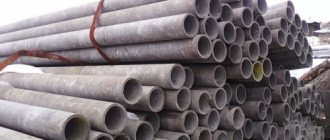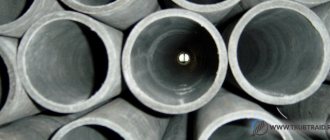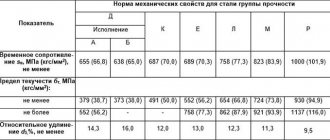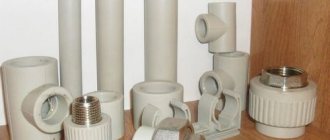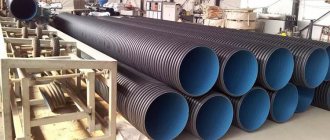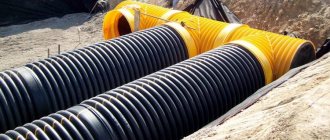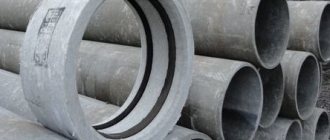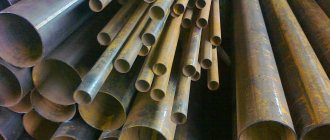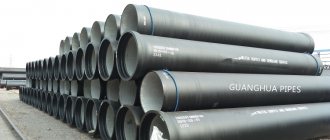Chrysotile cement pipes are products that are used for the installation of various communications.
The composition of chrysotile cement pipe includes cement, asbestos and water. Asbestos fiber, the share of which is approximately 20%, performs a protective function and serves as reinforcement. To produce these pipes, the most harmless type of asbestos cement is used - chrysotile. Chrysotile cement pipes belong to the class of stainless, high-strength, durable, harmless, non-flammable, environmentally friendly pipes. These characteristics are in many ways superior to other types of pipes: iron, concrete and plastic. Asbestos-cement (chrysotile-cement) pipes do not rust or oxidize compared to metal ones; in comparison with reinforced concrete, their composition (sand, cement) is not washed out; Compared to plastic pipes, asbestos-cement pipes have the advantage of ease of installation and environmental friendliness (they are non-toxic, do not contain low-quality plastic), and easy connection (no soldering apparatus is needed). The most important advantage of asbestos-cement pipes is their affordable low prices.
Chrysotile cement pipes are by far one of the best materials for performing work related to the installation of various types of communication systems.
Types of chrysotile cement pipes
All chrysotile cement products differ in length and internal diameter. Chrysotile cement parts can have internal cross-sectional dimensions from 100 to 500 millimeters. The length of such pipes ranges from 2950 to 5950 millimeters.
All chrysotile cement or asbestos cement pipes are divided according to quality characteristics and application features into two main types:
- pressure;
- non-pressure.
Non-pressure chrysotile cement pipes (BNT and BNTT)
These pipes can be of two types:
- ordinary ones, which are labeled BNT;
- thin-walled with BNTT marking.
Non-pressure chrysotile cement pipes (BNT) are used for various purposes:
- in drainage collectors of reclamation;
- for a gravity sewer main;
- in cable communication channels (perform a protective function);
- in ventilation communications;
- for the installation of garbage chutes;
- for chimney structures.
Often, a non-pressure chrysotile cement pipe is used to install a smoke exhaust duct, however, such pipes have certain limitations. For example, the temperature in a chrysotile cement structure should not exceed 300 °C. This means that they will cope well with the tasks if they are used for gas boilers that do not have very high power. And for heating systems running on solid fuel (coal, for example), it is better not to use products made from chrysotile cement.
In addition, non-pressure parts are used when arranging the foundations of houses. They produce a columnar monolithic foundation, which is suitable for structures with lightweight walls. For such purposes, products with a diameter from 100 to 200 mm are chosen.
Note! The BNT pipe undergoes a reinforcement procedure, and then a concrete solution is poured into it, which hardens and, as a result, a monolithic part is formed, which serves as a support for the building.
Pipe foundations are also used in the construction of buildings with a small number of floors. Depending on the weight of the building, a pipe with a diameter from 100 to 500 mm is selected. Such products undergo the same procedures (reinforcement and filling).
Non-pressure chrysotile cement pipes can be used for various purposes. It is also worth mentioning that they are often used to make various decorative elements that fit very harmoniously into the overall appearance of the site. From such parts you can make urns, flower beds, columns. If the product will be used as a decorative pole, it is recommended to fill the void inside it with sand or some other material. BNT chrysotile cement free-flow pipes sawn lengthwise can be used as drains.
Chrysotile cement pressure pipes
Chrysotile cement pressure pipes have higher strength characteristics. This is necessary in order to withstand the pressure of the work environment. They are used for installation:
- heat pipelines;
- water pipelines;
- oil pipelines.
The marking of pressure products depends on the specifics of their application. That is, the products that will be used during the installation of the water supply system are designated “VT”. And those parts from which the heating network is made are “TT”.
There is a division into 7 classes based on the operating pressure that a chrysotile cement pipe can withstand. These indicators vary from 0.3 to 1.6 MPa
Pressure parts can replace non-pressure parts in all cases. According to SNiP 41–20, they can serve consumers of the second and third categories. That is, they are allowed to be used for installing systems that can operate with interruptions in the heat supply. They are not used for continuous heating networks (continuous heating networks of the first category include: hospitals, children's institutions, etc.).
BNT 100 (GOST 1839-80)
Product manufacturing standard: GOST 1839-80
Non-pressure asbestos-cement pipes BNT 100 (GOST 1839-80)
has long been used in construction.
Due to its high environmental friendliness, this material is in special demand. Non-pressure pipes BNT 100 (GOST 1839-80)
are made from it .
In this case, the product is based on a combination of materials such as concrete and asbestos, the latter playing the role of reinforcing fibers. This ensures high strength and reliability of the structure. BNT 100 pipes (GOST 1839-80)
are straight cylindrical products without bends or corners. They are connected to each other using couplings of the same size group.
1. Options for writing markings.
Designates non-pressure pipes BNT 100 (GOST 1839-80)
according to
GOST 1839-80
alphanumeric combination. The marking itself can be written in different ways, which is not an error:
1. BNT 100 (GOST 1839-80);
2. BNT-100.
2.The main scope of application of the products.
non-pressure pipes BNT 100 are used
in the economic sphere, as well as in water supply and sewerage systems.
The biological resistance of the elements ensures that clean water will be supplied to the facility. Free-flow pipes can be used as garbage chutes, supports for technical structures, as chimney pipes for stoves and fireplaces, and also as piles. Also BNT 100 (GOST 1839-80)
can be used in irrigation and ventilation systems.
The use of free-flow asbestos-cement pipes for the construction of gas ducts and drainage collectors is practically justified, this is explained by low hydraulic resistance. Due to the low cost of BNT 100 (GOST 1839-80)
, they are in high demand; asbestos-cement pipes and various products are sold abroad.
3. Designation of product markings.
Non-pressure asbestos-cement pipes BNT 100
marked with a letter and number combination.
According to GOST 1839-80,
indicate the type of product and its main dimensions.
BNT 100 (GOST 1839-80)
, Where:
1. BNT – free-flow pipe;
2. 100 – nominal diameter, Dy.
The dimensions of the pipe are 3950x118x118
, where the length, outer and inner diameters are indicated respectively.
Additional parameters for BNT 100 (GOST 1839-80)
: weight is
24.09
;
0.012
is consumed per product ;
the geometric volume is 0.055.
The marking is applied with black paint on the side surface. Also indicate the trademark, batch number and date of manufacture. A technical passport is provided for the product (for example, the document must indicate not only basic data on the supplied pipes, but also data on their testing).
4.Main characteristics and materials for manufacturing.
Manufacturing technology and basic requirements for asbestos-cement pipes BNT 100 (GOST 1839-80)
are enshrined in
GOST 1839-80
and are mandatory. The main material is fiber-reinforced concrete. Properties such as water resistance and frost resistance expand the scope of application of chrysotile cement products.
Concrete (80% is taken), reinforced with 15% asbestos, has high performance characteristics, which makes it possible to obtain high-tech elements. Finished products can be used under prolonged exposure to aggressive environments. Also BNT 100 (GOST 1839-80)
They are corrosion resistant and do not require additional processing, which will significantly reduce the cost of the construction project. Please note that as a result of corrosion, steel pipes fail after 5-10 years, while asbestos-cement pipes last at least 25-50 years.
The kit includes polyethylene or chrysotile cement couplings equipped with O-rings, which ensure high tightness of the connection. This also ensures the plasticity of the joint; temperature deformations do not break the joint.
They are widely used in construction, as they have a number of significant advantages over other pipes:
1. High throughput;
2. Strength characteristics;
3. Long service life;
4. Safe for use in water supply systems, will not rot, crack or crumble;
5. They are light in weight, which allows the construction of lightweight supporting structures;
6. An undoubted advantage is low thermal conductivity, so the construction of additional waterproofing is not required.
5.Transportation and storage.
Non-pressure pipes BNT 100 (GOST 1839-80)
transported in a horizontal “working” position.
Additionally, the products are secured with steel tape or other fasteners. Wooden pads are used as a base for laid pipe bundles. Large quantities are transported by rail. During unloading, products must not be dumped or piled up. BNT 100 (GOST 1839-80)
is stored in stacks, the height should not exceed 2.5 meters. The formed layers between pipe starts are laid with wooden boards or cushioning material.
Dear customers! The site is for informational purposes only. The information provided on the website is not a public offer (Article 435 of the Civil Code of the Russian Federation). Please check the cost and availability of goods at the sales office or by phone
Price for chrysotile cement pipes
| Name | Internal and external diameter, mm | Pipe weight, kg | Pipe price, rub. |
| BT 100x3950 | 97-111 | 17.8 | 625-00 |
| BT 150x3950 | 137-153 | 28.44 | 1 040-00 |
| BNT 200x5000 | 180-202 | 86 | 2 575-00 |
| BT 250x5000 | 226-250 | 101 | 3 522-00 |
| BT 300x5000 | 267-293 | 133 | 5 115-00 |
| BT 400x5000 | 361-395 | 270.5 | 7 750-00 |
| BT 500x5000 | 435-483 | 351.5 | 15 735-00 |
TECHNICAL REQUIREMENTS
2.1. Pipes and couplings must be produced in accordance with the requirements of this standard according to technological regulations approved in the prescribed manner.
2.2. Pipes and couplings must be straight and cylindrical. Deviation from pipe straightness should not exceed:
12 mm - for pipes with a length of 2950 mm;
16 mm » » » 3950 mm.
2.3. Pipes and couplings must not have cracks, breaks or delaminations.
2.4. On the outer surface of pipes and couplings, prints of technical cloth and abrasions with a depth of no more than 2 mm are allowed, and on the inner surface - prints of the knurled surface of format rolling pins.
2.5. (Deleted, Amendment No. 1).
2.6. Pipes and couplings must be watertight and, when tested with hydraulic pressure, there must be no signs of water penetration on the outer surface.
The value of the test hydraulic pressure for pipes and couplings must be at least 0.4 MPa (4 kgf/cm2), and for pipes and couplings of the highest quality category - at least 0.6 MPa (6 kgf/cm2).
2.7. When tested for crushing in a water-saturated state, pipe samples must withstand the loads indicated in Table. 5.
Table 5
| Nominal diameter of pipes, mm | Minimum load when testing pipe samples for crushing, N (kgf) |
| 100 | 4508 (460) |
| 150 | 3920 (400) |
| 200 | 3136 (320) |
| 300 | 4116 (420) |
| 400 | 4900 (500) |
When tested for crushing in a water-saturated state, samples of pipes of the highest quality category must withstand the loads specified in Table. 6.
Table 6
| Nominal diameter of pipes, mm | Minimum load when testing pipe samples for crushing, N (kgf) |
| 100 | 5253 (540) |
| 150 | 4567 (470) |
| 200 | 3646 (370) |
| 300 | 4802 (490) |
| 400 | 5253 (540) |
2.8. The minimum breaking load when testing pipes for bending in N (kgf) should be:
for pipes with a nominal diameter of 100 mm - 1764 (180);
» » » » 150 mm - 3920 (400);
for pipes of the highest quality category:
nominal bore 100 mm - 2254 (230);
"" 150 mm - 4704 (480).
2.9. (Deleted, Amendment No. 1).
Price for chrysotile cement non-pressure couplings
| Name | Internal and external diameter, mm | Coupling weight, kg | Coupling price, rub. |
| BNM 100 | 140-160 | 1.4 | 180-00 |
| BNM 150 | 189-213 | 2.3 | 235-00 |
| BNM 200 | 221-249 | 5.1 | 300-00 |
| BNM 250 | 238-326 | 6.4 | 380-00 |
| BNM 300 | 324-356 | 7.6 | 430-00 |
| BNM 400 | 422-458 | 11.5 | 570-00 |
| BNM 500 | 525-575 | 16.3 | 890-00 |
For detailed information about the availability and delivery conditions of goods, please contact the sales department using the special form below or by phone;
8(499)922-09-01 Online form
SHAPE AND SIZES
1.1. The shape of the pipes must correspond to that indicated in the drawing. 1, and the dimensions are indicated in the table. 1.
Crap. 1
Table 1
mm
| Conditional pass | Diameter | Wall thickness s | Length L | |
| outer D | internal* d | |||
| 100 | 118 | 100 | 9 | 2950; 3950 |
| 150 | 161 | 141 | 10 | 2950; 3950 |
| 200 | 211 | 189 | 11 | 3950 |
| 300 | 307 | 279 | 14 | 3950 |
| 400 | 402 | 368 | 17 | 3950 |
_____
* Inner diameter dimensions are for reference only.
Note. The production of pipes with a nominal bore of more than 150 mm until January 1, 1984 is carried out at the request of the consumer with the consent of the manufacturer.
1.2. Deviations of pipe sizes from the nominal ones should not exceed the values indicated in the table. 2.
table 2
mm
| Conditional pass | Deviations | ||
| according to the outer diameter of the pipe | by wall thickness | along the length of the pipe | |
| 100 | ±2,5 | ±1,5 | -50,0 |
| 150 | |||
| 200 | |||
| 300 400 | ±3,0 | ±2,0 | |
Note. The plus tolerance for pipe wall thickness is given as a guide and is not a rejection criterion.
(Changed edition, Amendment No. 1).
1.3. The shape and dimensions of the couplings must correspond to those indicated in the drawing. 2 and in table. 3.
Crap. 2
Table 3
mm
| Nominal diameter of pipes | Diameter | Wall thickness S1 | Length l | |
| outer* D 2 | interior D 1 | |||
| 100 | 160 | 140 | 10 | 150 |
| 150 | 212 | 188 | 12 | 150 |
| 200 | 262 | 234 | 14 | 150 |
| 300 | 366 | 334 | 16 | 150 |
| 400 | 477 | 441 | 18 | 180 |
_____
* The dimensions of the outer diameters of the couplings are for reference only.
1.4. Deviations of coupling dimensions from the nominal ones should not exceed the values indicated in the table. 4.
Table 4
mm
| Nominal diameter of pipes | Deviations | ||
| by inner diameter | by wall thickness | by lenght | |
| 100 | +1,5 -1,0 | ±1,5 | ±3,0 |
| 150 200 | ±2,0 | ||
| 300 400 | ±3,0 | ||
1.5. The symbol for asbestos-cement pipes for non-pressure pipelines must consist of the letter designation BNT, the nominal diameter in millimeters and the designation of this standard.
An example of a pipe symbol with a nominal bore of 100 mm:
BNT 100 GOST 1839-80
The symbol of a coupling for connecting pipes must consist of the letter designation BNM, the nominal diameter of the pipe for which the coupling is intended, in mm, and the designation of this standard.
An example of a designation for a coupling for pipes with a nominal bore of 400 mm:
BNM 400 GOST 1839-80
ACCEPTANCE RULES
4.1. Each batch of pipes and couplings must be accepted by the technical control service of the manufacturer in accordance with the requirements of this standard.
(Changed edition, Amendment No. 3)
4.2. Acceptance of pipes and couplings is carried out in batches. The batch size is set in the amount of shift output of one production line.
The batch must include pipes (couplings) of the same diameter.
(Changed edition, Amendment No. 2).
4.3. Acceptance rules - according to GOST 30301-95.
(Changed edition, Amendment No. 3)
4.4. When carrying out inspections and control by the consumer, the selection procedure, the number of selected pipes and couplings (sample volume) and assessment of the control results are in accordance with GOST 30301-95.
(Changed edition, Amendment No. 3)
LABELING, STORAGE AND TRANSPORTATION
6.1. The following must be painted on the outer surface of each pipe: the trademark or name of the manufacturer, the batch number and symbol of the pipe, as well as the inscription “do not throw”, and on each coupling - the nominal bore of the pipe for which the coupling is intended, and the batch number.
On the outer surface of at least 10% of the pipes and couplings from the batch, the Quality Control Department stamp must be painted.
6.2. The manufacturer must guarantee compliance of pipes and couplings with the requirements of this standard and accompany each batch with a document certifying their quality, which indicates:
a) name and address of the manufacturer;
b) number and date of issue of the document;
c) pipe batch number, symbol, total quantity in pieces and meters;
d) batch number of couplings, symbol, number of couplings in pieces;
e) test results of pipes (couplings);
f) designation of this standard.
(Changed edition, Amendment No. 1).
6.3. During storage, pipes and couplings must be stacked on a flat area according to their diameters: pipes in horizontal rows, and couplings in vertical rows.
On uneven ground, wooden shims should be placed under the bottom row of pipes. The bottom row of pipes must be secured.
6.4. Pipes and couplings transported by rail must be placed in special containers. Transportation of pipes and couplings without containers is allowed, and their placement must be carried out in accordance with the technical conditions for the placement and fastening of asbestos-cement pipes in four-axle gondola cars, approved by the Ministry of Railways of the USSR.
(Changed edition, Amendment No. 1).
6.5. When transporting by other means of transport, the pipes must be tightly secured. Transportation of pipes in dump trucks is prohibited.
6.6. When loading and unloading, it is not allowed to hit pipes and couplings, or drop them from any height.
